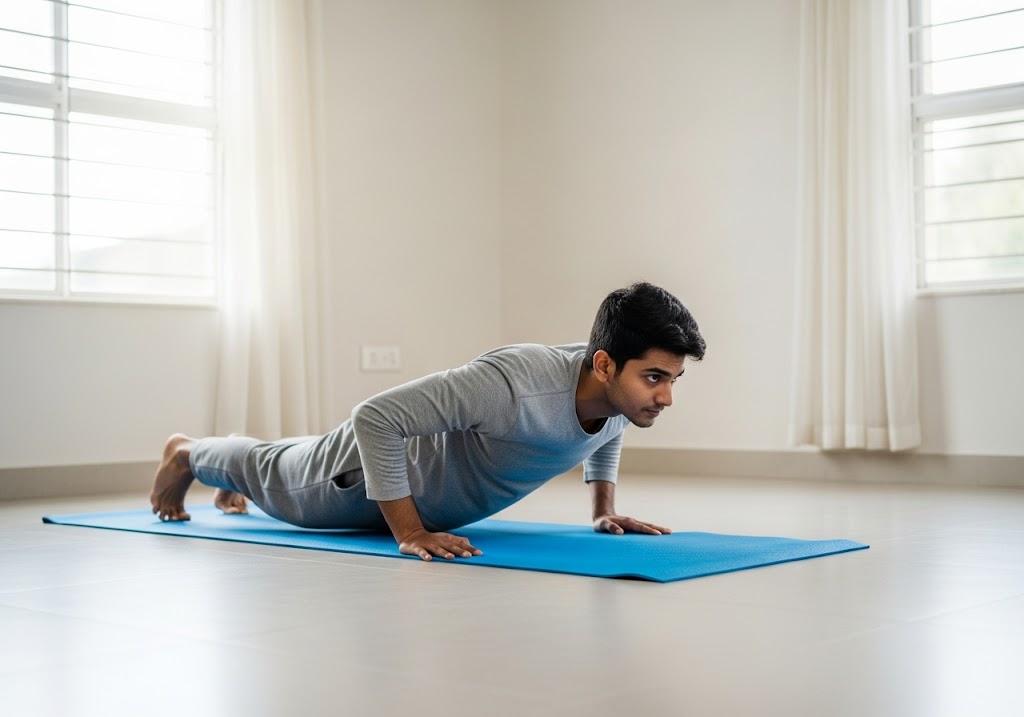10 Best Somatic Pilates Exercises are: Arch and Flatten for spinal awareness, Knee Rocks for hip mobility, Washrag for spinal rotation, Walking Preparation for leg coordination, Flower Exercise for body integration, Side Bend Reset for lateral flexibility, Eye Movement Integration for neck relief, Jaw Release for facial tension, Foot and Ankle Awakening for lower leg awareness, and Diagonal Reach and Release for cross-body coordination.
Want to discover how somatic Pilates can transform your relationship with movement and reduce chronic tension? This gentle yet powerful approach combines traditional Pilates principles with somatic awareness techniques to help you reconnect with your body’s natural movement patterns. Somatic Pilates emphasizes slow, mindful movements that retrain your nervous system and release deeply held muscle tension.
Table of Contents
What Is Somatic Pilates?
Somatic Pilates is a mindful movement practice that combines the core strengthening principles of traditional Pilates with somatic awareness techniques. This approach focuses on slow, conscious movements that help you develop better body awareness and release chronic muscle tension through nervous system re-education.
Unlike traditional exercise that often pushes through discomfort, somatic Pilates encourages you to move within your comfort zone while paying close attention to internal sensations. This method helps reset your nervous system’s habitual patterns and allows your muscles to return to their natural resting length for lasting relief.
For those interested in complementary bodyweight training, exploring bodyweight exercises for beginners provides additional movement options that support overall fitness.

10 Somatic Pilates Exercises
These ten foundational somatic Pilates exercises introduce you to the essential movement patterns and principles of somatic awareness. Each exercise focuses on different aspects of nervous system re-education and muscle tension release through slow, mindful movement exploration.
| Exercise | Primary Focus | Position | Duration | Benefits |
|---|---|---|---|---|
| Arch and Flatten | Spinal awareness | Lying on back | 8-10 repetitions | Back tension relief |
| Knee Rocks | Hip mobility | Lying, knees bent | 5-8 each direction | Hip flexibility |
| Washrag | Spinal rotation | Lying on back | 5-6 each side | Spinal mobility |
| Walking Preparation | Leg coordination | Lying on back | 10-12 each leg | Gait improvement |
| Flower Exercise | Limb coordination | Lying on back | 5-8 repetitions | Full body integration |
| Side Bend Reset | Lateral flexibility | Standing or sitting | 5-6 each side | Side body release |
| Eye Movement Integration | Visual-motor connection | Any position | 2-3 minutes | Neck tension relief |
| Jaw Release Integration | TMJ relief | Seated or lying | 3-5 minutes | Facial tension release |
| Foot and Ankle Awakening | Lower leg awareness | Seated or lying | 5-10 each foot | Foundation stability |
| Diagonal Reach and Release | Cross-pattern coordination | Standing or seated | 6-8 each side | Whole body integration |
1. Arch and Flatten
Lie on your back with knees bent and feet flat on the floor. Slowly arch your lower back by tilting your pelvis forward, then flatten it against the floor by tilting your pelvis backward. Move very slowly and notice the sensations in your lower back, pelvis, and legs as you explore this fundamental spinal movement.
2. Knee Rocks
From the same position, let your knees fall gently to one side, then bring them back to center and over to the other side. Keep your shoulders on the ground and move only as far as feels comfortable. This exercise releases hip tension and improves rotational mobility in the spine.
3. Washrag
Lying on your back with arms extended to the sides, slowly turn your head to the right while letting your knees fall to the left. Return to center, then reverse the movement. This cross-lateral pattern helps release tension throughout the entire torso and improves spinal rotation.
4. Walking Preparation
Lying on your back, slowly slide one heel away from your body along the floor, then slide it back. Notice how this simple movement affects your entire body, including your back, pelvis, and even your shoulders. This exercise helps improve the neuromuscular patterns involved in walking.
5. Flower Exercise
Lying on your back with arms and legs extended, slowly gather your limbs toward your center like a flower closing, then slowly extend them back out like a flower opening. Focus on the coordination between all four limbs and the gentle contraction and release of your entire body.
6. Side Bend Reset
From sitting or standing, slowly lean to one side, leading with your head and letting the movement flow down through your ribs and waist. Return to center with the same slow, flowing quality. This exercise releases tension in the lateral muscles and improves side-to-side balance.
7. Eye Movement Integration
Slowly move your eyes in different directions – up, down, left, right, and in circles – while noticing how these movements affect tension in your neck, jaw, and shoulders. This exercise helps release the complex connections between visual focus and muscular tension.
8. Jaw Release Integration
Gently open and close your mouth while paying attention to how this movement affects your neck, shoulders, and even your breathing. Include small jaw movements side to side and gentle massage of the jaw muscles. This exercise addresses the often-overlooked tension patterns in the face and jaw.
9. Foot and Ankle Awakening
Slowly point and flex your feet, circle your ankles, and gently spread and curl your toes. Notice how these movements travel up through your legs and into your pelvis and back. This foundational exercise improves the stability and awareness of your base of support.
10. Diagonal Reach and Release
Slowly reach one arm across your body toward the opposite side while allowing your torso to spiral gently. Return to center and repeat on the other side. This cross-lateral movement pattern integrates the entire body and improves coordination between upper and lower body movement.
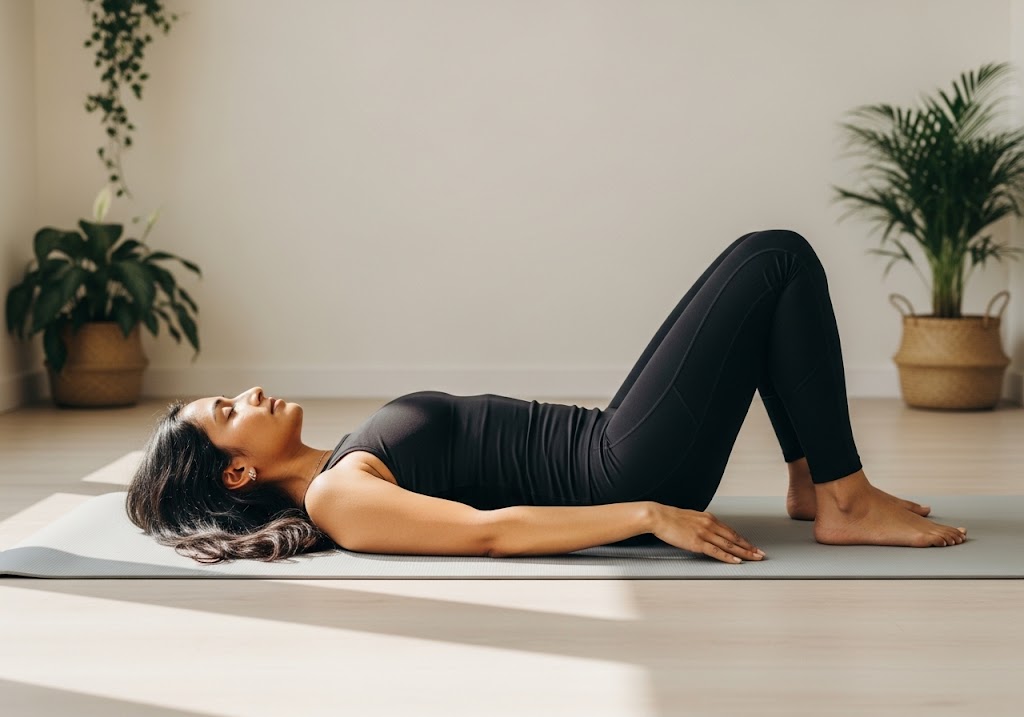
Core Principles of Somatic Pilates
The core principles of somatic Pilates guide practitioners toward greater body awareness and improved movement quality. These fundamental concepts distinguish somatic Pilates from other exercise methods by emphasizing internal awareness over external performance.
- Slow and Mindful Movement forms the foundation of somatic Pilates practice. Every movement is performed slowly and deliberately, allowing your nervous system time to process new information and create lasting changes in muscle tension patterns.
- Internal Awareness encourages you to focus on how movements feel rather than how they look. This principle helps develop proprioception and teaches you to recognize subtle differences in muscle tension and body alignment.
- Pandiculation involves the conscious contraction and slow release of muscles, similar to how animals naturally stretch upon waking. This process helps reset muscle length and reduces chronic tension through nervous system re-education.
- Comfort and Ease prioritize moving within pain-free ranges while avoiding force or strain. This principle allows your nervous system to feel safe and receptive to change, leading to more effective and lasting results.
- Breath Awareness integrates conscious breathing with movement, helping to calm the nervous system and enhance the mind-body connection throughout your somatic Pilates practice.
Difference Between Traditional Pilates and Somatic Pilates
Understanding the key differences between traditional Pilates and somatic Pilates helps you choose the approach that best serves your current needs and goals. While both practices offer valuable benefits, they emphasize different aspects of movement and body awareness.
| Aspect | Traditional Pilates | Somatic Pilates | Key Difference |
|---|---|---|---|
| Movement Speed | Moderate to fast pace | Very slow, deliberate | Nervous system processing time |
| Focus | External form, alignment | Internal sensation, awareness | Attention direction |
| Intensity | Challenging, progressive | Gentle, comfortable | Effort level |
| Goals | Strength, flexibility, posture | Nervous system reset, tension release | Primary objective |
| Repetitions | Fixed sets, multiple reps | Few repetitions, quality focus | Quantity approach |
| Muscle Engagement | Active strengthening | Conscious contraction-release | Engagement style |
| Pain Approach | Work through mild discomfort | Stay within comfort zone | Pain tolerance |
| Breathing | Coordinated with movement | Awareness-based, natural | Breathing integration |
Traditional Pilates emphasizes building strength, improving posture, and increasing flexibility through structured exercises and precise alignment. It often involves challenging positions and progressive difficulty levels to build physical conditioning.
Somatic Pilates prioritizes nervous system education and muscle tension release through gentle, exploratory movements. The practice focuses on quality of awareness rather than quantity of repetitions or achievement of specific positions.
For those seeking comprehensive fitness routines, full body calisthenics workout provides structured strength training that complements the gentle awareness work of somatic Pilates.

What Are the Benefits of Somatic Pilates?
Somatic Pilates offers unique benefits that address both physical and mental well-being through nervous system re-education. These benefits often develop gradually as your body learns to release chronic tension patterns and move with greater ease and efficiency.
- Chronic Pain Relief: Helps reduce persistent muscle tension and pain by addressing the nervous system patterns that maintain these conditions
- Improved Body Awareness: Develops better proprioception and understanding of your body’s needs and limitations
- Stress Reduction: Activates the parasympathetic nervous system, promoting relaxation and reducing cortisol levels
- Better Sleep Quality: Releases physical tension and calms the nervous system, leading to more restful sleep
- Enhanced Flexibility: Increases range of motion by releasing muscular holding patterns rather than forcing stretches
- Improved Posture: Helps restore natural alignment by releasing compensatory muscle tensions
- Reduced Anxiety: Combines movement with mindfulness to calm mental chatter and promote emotional balance
- Faster Recovery: Aids in muscle recovery and reduces inflammation through gentle, therapeutic movement
The benefits of somatic Pilates extend beyond the practice session, as the nervous system changes create lasting improvements in how you move and feel throughout daily activities.
Do Somatic Workouts Really Work?
Research and clinical experience demonstrate that somatic workouts, including somatic Pilates, can be highly effective for addressing chronic pain, improving movement quality, and reducing stress-related symptoms. The effectiveness comes from working with your nervous system rather than against it through gentle, mindful movement approaches.
Scientific studies on somatic movement show significant improvements in pain reduction, range of motion, and functional movement patterns. The slow, mindful approach allows the nervous system to process and integrate new movement patterns more effectively than forced movements, creating lasting changes in how you move and feel daily.
For those interested in building strength alongside somatic awareness, basic calisthenics workout provides foundational exercises that complement mindful movement practices.
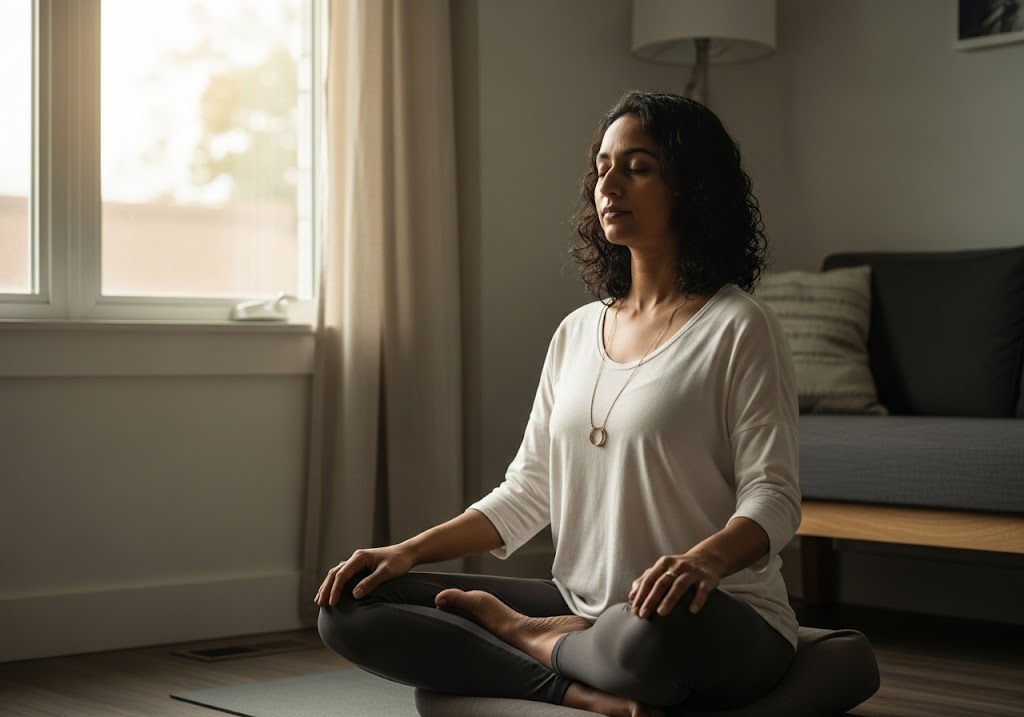
Can You Lose Weight with Somatic Pilates?
While somatic Pilates is not primarily designed for weight loss, it can support healthy weight management through stress reduction, improved body awareness, and enhanced movement quality. The practice helps address underlying factors that contribute to weight gain and difficulty losing weight effectively.
Stress reduction through somatic Pilates helps lower cortisol levels, which can reduce stress-related eating and belly fat accumulation. However, significant weight loss typically requires additional cardiovascular exercise and dietary changes, with somatic Pilates working best as part of a comprehensive wellness approach.
For more intensive calorie-burning workouts, hiit workout in mumbai provides high-intensity training options that complement the gentle approach of somatic Pilates.
Who Can Benefit from Somatic Pilates?
Somatic Pilates is suitable for people of all ages and fitness levels, particularly those dealing with chronic pain, stress, or movement limitations. The gentle, adaptable nature of the practice makes it accessible to almost everyone.
- People with Chronic Pain often find significant relief through somatic Pilates as it addresses the nervous system patterns that maintain pain cycles. Conditions like fibromyalgia, chronic back pain, and tension headaches may improve with regular practice.
- Highly Stressed Individuals benefit from the calming effects of slow, mindful movement combined with breath awareness. The practice activates the relaxation response and provides tools for managing daily stress more effectively.
- Seniors and Older Adults appreciate the gentle, safe approach that improves mobility without risk of injury. Somatic Pilates helps maintain independence and quality of life through better movement and reduced fall risk.
- Athletes and Active Individuals use somatic Pilates for recovery, injury prevention, and performance enhancement. The practice helps release compensatory tensions that develop from repetitive training and competition stress.
- People in Sedentary Jobs find relief from the postural tensions and movement restrictions that develop from prolonged sitting and computer work. Regular practice helps counteract these effects and restore natural movement patterns.

What Are the Possible Risks of Somatic Pilates?
Somatic Pilates is generally very safe due to its gentle, non-forcing approach, but understanding potential risks helps ensure a positive experience. Most risks can be avoided through proper instruction and listening to your body’s signals.
- Emotional Release may occur as the body releases stored tension and trauma. While this is often therapeutic, it can feel overwhelming for some people. Working with a qualified instructor helps navigate these experiences safely.
- Initial Discomfort might arise as your body adjusts to new movement patterns. This usually indicates positive changes occurring, but distinguishing between therapeutic discomfort and harmful pain requires experience and guidance.
- Overexertion can happen if you try to force movements or practice too intensively. The key principle of staying within comfort zones helps prevent this risk while still achieving benefits.
- Inappropriate Expectations about quick results can lead to disappointment. Understanding that somatic work creates gradual, lasting changes helps maintain realistic expectations and consistent practice.
- Most people find somatic Pilates remarkably safe and beneficial when practiced mindfully and with proper guidance from qualified instructors.
- For those seeking to complement somatic work with strength training, understanding how to start calisthenics provides a foundation for building physical capacity alongside body awareness.
Somatic Pilates Exercises You Can Do at Home
These home-friendly somatic Pilates exercises help you develop body awareness and release tension in the comfort of your own space. Practice these movements slowly and mindfully, focusing on internal sensations rather than perfect form.
| Exercise | Target Area | Duration | Position | Benefits |
|---|---|---|---|---|
| Cat-Cow Stretch | Spine | 5-10 breaths | Hands and knees | Spinal mobility |
| Spinal Wave | Entire spine | 5-8 repetitions | Seated or standing | Nervous system reset |
| Hip Circles | Hips, pelvis | 5 each direction | Standing | Hip freedom |
| Shoulder Blade Squeezes | Upper back | 10-15 repetitions | Any position | Posture improvement |
| Gentle Spinal Twist | Spine, core | 5 each side | Seated | Spinal rotation |
| Pelvic Tilts | Lower back, pelvis | 10-15 repetitions | Lying down | Lower back relief |
| Side Lying Leg Slides | Hips, legs | 8-10 each side | Side lying | Hip alignment |
| Arm Circles | Shoulders, arms | 5 each direction | Standing | Shoulder freedom |
| Neck Release | Neck, shoulders | 30 seconds each | Seated | Tension relief |
| Breathing Awareness | Whole body | 5-10 minutes | Any position | Nervous system calm |
Begin with just a few exercises and gradually add more as you become familiar with the somatic approach. Listen to your body and modify movements as needed to stay within your comfort zone.
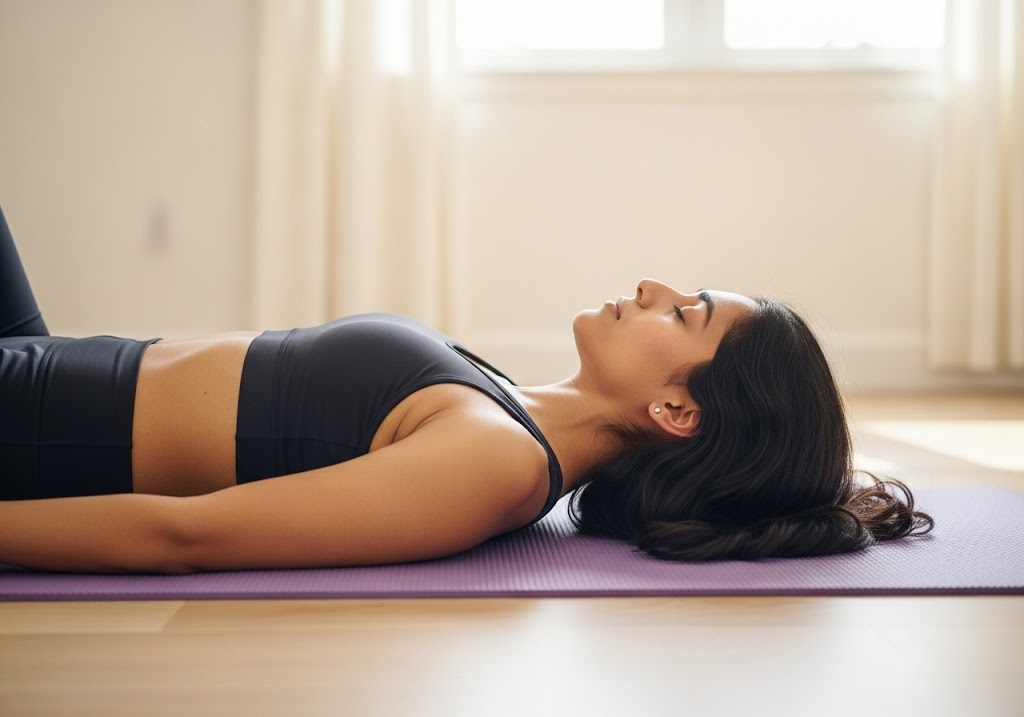
7 Somatic Pilates Exercises to Reduce Stress
These specific somatic Pilates exercises are particularly effective for stress reduction and nervous system calming. Each movement is designed to activate the parasympathetic nervous system, reduce cortisol levels, and help you find deep relaxation through gentle, mindful body awareness and conscious breathing techniques.
| Exercise | Target Area | Duration | Position | Stress Relief Focus |
|---|---|---|---|---|
| Conscious Breathing | Nervous system | 5-10 minutes | Lying down | Anxiety reduction |
| Progressive Muscle Release | Full body | 10-15 minutes | Lying down | Tension release |
| Gentle Spinal Waves | Spine, core | 5-8 repetitions | Sitting/standing | Nervous system reset |
| Shoulder and Neck Reset | Upper body | 8-10 repetitions | Any position | Physical tension relief |
| Hip Circles and Figure-8s | Lower body | 5 minutes | Standing | Emotional release |
| Arm Swings and Circles | Arms, shoulders | 3-5 minutes | Standing | Mental tension relief |
| Full-Body Shake and Release | Whole body | 1-2 minutes | Standing | Complete stress reset |
1. Conscious Breathing
Lie comfortably and place one hand on your chest, one on your belly. Breathe naturally and notice which hand moves more. Gradually allow your belly hand to move more than your chest hand, encouraging deeper, more relaxing breaths.
2. Progressive Muscle Release
Starting with your feet, gently contract each muscle group for 3-5 seconds, then release completely. Notice the contrast between tension and relaxation as you work systematically through your entire body.
3. Gentle Spinal Waves
From sitting or standing, slowly round your spine vertebra by vertebra, then slowly reverse the movement. Focus on the sensation of each spinal segment moving individually rather than rushing through the motion.
4. Shoulder and Neck Reset
Slowly lift your shoulders toward your ears, hold for a moment, then release with a sigh. Repeat several times, paying attention to the sensation of release and the settling that follows.
5. Hip Circles and Figure-8s
Standing with feet hip-width apart, slowly circle your hips in both directions. Try figure-8 patterns and notice which movements feel most satisfying and releasing to your lower back and hips.
6. Arm Swings and Circles
Let your arms hang loosely and gently swing them forward and back, then side to side. Progress to arm circles, focusing on the feeling of weight and momentum rather than muscular effort.
7. Full-Body Shake and Release
Standing with feet hip-width apart, begin gently shaking your hands, then arms, then your whole body. Continue for 30-60 seconds, then stop suddenly and notice the sensations as your body settles.
For additional stress management techniques, exploring warm up exercises for beginners provides gentle movement options that complement somatic practices.
Why Practice Somatic Pilates?
Somatic Pilates offers a unique approach to health and wellness that addresses the root causes of many physical and emotional challenges. The practice provides tools for self-regulation and body awareness that extend far beyond the exercise session.
- Long-term Pain Relief comes from addressing the nervous system patterns that maintain chronic tension and pain. Unlike treatments that provide temporary relief, somatic Pilates teaches your body new ways of being that prevent problems from recurring.
- Improved Quality of Life results from better movement, reduced pain, and enhanced body awareness. People often report feeling more comfortable in their bodies and more capable of enjoying daily activities and relationships.
- Stress Management Skills develop through the integration of mindful movement with breath awareness. These skills transfer to daily life, helping you navigate challenges with greater ease and resilience.
- Enhanced Self-Awareness grows through the practice of internal listening and body awareness. This often leads to better decision-making about lifestyle choices, relationships, and self-care practices.
- Natural Movement Restoration helps you rediscover your body’s innate wisdom and movement patterns. This can improve athletic performance, reduce injury risk, and enhance overall physical confidence.
For those interested in exploring advanced bodyweight movements, advanced calisthenics routine provides challenging exercises that can complement the foundation of body awareness developed through somatic Pilates.
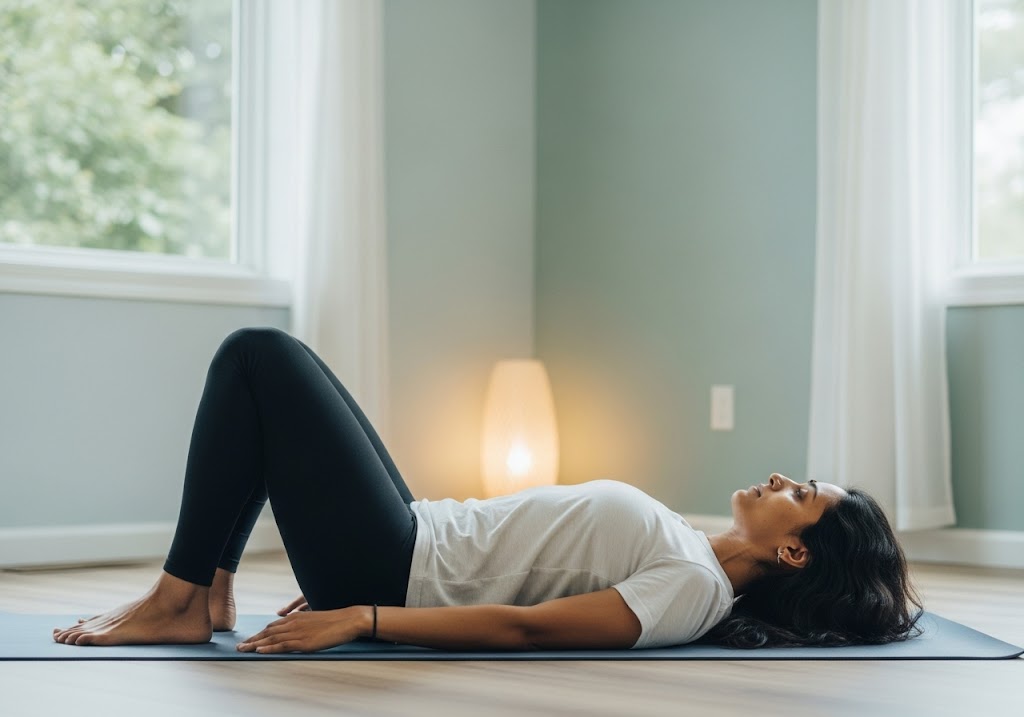
Getting Started with Somatic Pilates
Beginning your somatic Pilates journey requires a shift in mindset from goal-oriented exercise to process-oriented exploration. This approach emphasizes quality of awareness over quantity of movement, focusing on internal sensations rather than external appearance for meaningful and lasting changes.
| Getting Started Phase | Duration | Focus | Key Activities |
|---|---|---|---|
| Week 1-2 | 10-15 min daily | Basic awareness | Simple breathing, gentle movements |
| Week 3-4 | 15-20 min daily | Movement exploration | Joint circles, spinal waves |
| Week 5-8 | 20-30 min daily | Pattern integration | Combining movements, sequences |
| Ongoing | 20-45 min daily | Personal practice | Intuitive movement, self-care |
Start with simple movements performed very slowly, focusing on internal sensations rather than external appearance. Spend 10-15 minutes daily exploring basic movements like gentle spinal waves, breathing awareness, and simple joint circles.
Create a quiet, comfortable space where you can practice without distractions. Wear loose, comfortable clothing that doesn’t restrict movement, and consider using a yoga mat or soft surface for floor exercises.
Work with qualified instructors when possible, especially in the beginning. Online classes and videos can be helpful, but personalized guidance helps ensure you’re practicing safely and effectively.
Be patient with the process, as somatic changes occur gradually. Focus on how you feel during and after practice rather than trying to achieve specific outcomes or compare yourself to others.
Combining Somatic Pilates with Other Practices
Somatic Pilates integrates beautifully with other wellness practices and forms of exercise. The body awareness and nervous system regulation developed through somatic work enhances the benefits of other activities.
- Yoga and Somatic Pilates complement each other well, with somatic awareness enhancing yoga practice and yoga poses providing structure for somatic exploration. The mindful approach of both practices creates synergistic benefits for flexibility and stress reduction.
- Strength Training and Somatic Pilates work together effectively when somatic work is used for warm-up, cool-down, or recovery days. The body awareness developed through somatic practice improves form and reduces injury risk in strength training.
- Cardiovascular Exercise benefits from the improved body awareness and movement quality developed through somatic Pilates. Better alignment and nervous system regulation can enhance endurance and reduce exercise-related stress.
For structured strength training that complements somatic awareness, does calisthenics build muscle explores how bodyweight exercises can build strength while maintaining body awareness.
Nutrition and Lifestyle Support for Somatic Pilates
Supporting your somatic Pilates practice with appropriate nutrition and lifestyle choices enhances the benefits and accelerates positive changes. The nervous system requires specific nutrients and conditions to function optimally and adapt to new patterns.
- Hydration plays a crucial role in nervous system function and muscle health. Adequate water intake supports the body’s ability to release toxins and maintain optimal tissue function during somatic practice.
- Anti-inflammatory Foods help reduce systemic inflammation that can interfere with nervous system healing and adaptation. Focus on whole foods, omega-3 fatty acids, and antioxidant-rich fruits and vegetables.
- Stress Management beyond your somatic practice supports nervous system health through adequate sleep, stress reduction techniques, and healthy boundaries. The benefits of somatic Pilates are enhanced when supported by overall lifestyle wellness.
- Mindful Eating practices complement the body awareness developed through somatic Pilates. Paying attention to hunger, fullness, and how different foods affect your energy and well-being supports overall health goals.
For comprehensive nutrition guidance that supports movement practices, calisthenics diet chart provides structured meal planning that can be adapted for somatic wellness goals.
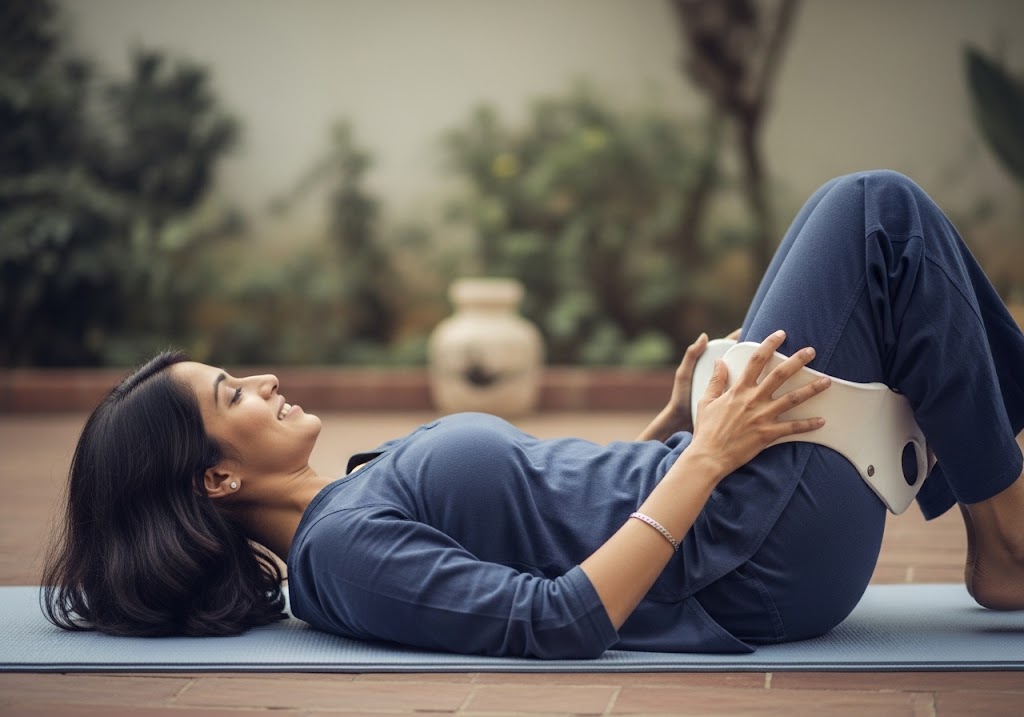
Common Challenges and Solutions in Somatic Pilates
Understanding common challenges helps you navigate your somatic Pilates journey with realistic expectations and effective strategies. Most challenges are part of the normal learning process and resolve with consistent practice and proper guidance.
- Impatience with Slow Progress is common in our fast-paced culture. Remember that nervous system changes take time, and the slow approach of somatic Pilates is designed to create lasting changes rather than quick fixes.
- Difficulty Feeling Internal Sensations may occur initially, especially if you’re used to external focus. Start with larger, more obvious movements and sensations, gradually developing sensitivity to subtler experiences.
- Emotional Reactions can arise as the body releases stored tension and trauma. This is often part of the healing process, but working with qualified instructors helps navigate these experiences safely and effectively.
- Inconsistent Practice undermines the cumulative benefits of somatic work. Even 10-15 minutes daily is more beneficial than longer, infrequent sessions. Focus on consistency over duration.
- Comparing to Other Exercise can create unrealistic expectations. Somatic Pilates serves different purposes than fitness-oriented exercise, and the benefits are often subtle but profound.
Advanced Somatic Pilates Concepts
As your somatic Pilates practice develops, you can explore more sophisticated concepts that deepen your understanding and enhance the benefits. These advanced ideas build upon the foundation of basic body awareness and nervous system education.
- Whole-Body Integration involves recognizing how movement in one area affects the entire body. Advanced practitioners learn to sense and work with these connections for more comprehensive healing and improved function.
- Emotional-Physical Connections become more apparent with practice, as you notice how emotions affect muscle tension and movement patterns. This awareness provides powerful tools for emotional regulation and stress management.
- Movement Patterns and Habits can be explored and gradually changed through conscious practice. This work often addresses deep-seated patterns that affect posture, gait, and overall movement quality.
- Trauma-Informed Practice recognizes that physical tension often relates to stored emotional experiences. Advanced somatic work may involve working with these connections under appropriate guidance.
For those interested in exploring advanced movement skills, calisthenics planche demonstrates how body awareness supports complex physical achievements.
Creating a Home Practice Routine
Establishing a consistent home practice is essential for experiencing the full benefits of somatic Pilates. A regular routine allows your nervous system to integrate changes and develop new, healthier patterns over time.
- Morning Practice can help you start the day with body awareness and nervous system regulation. Even 10-15 minutes of gentle movement and breathing can improve your entire day’s experience.
- Evening Practice focuses on releasing the day’s accumulated tension and preparing for restful sleep. Longer, more restorative sessions work well in the evening when you have more time and need to wind down.
- Micro-Practices throughout the day help maintain awareness and prevent tension buildup. Simple exercises like shoulder releases, breathing awareness, or gentle spinal movements can be done anywhere.
- Weekly Structure might include longer sessions 2-3 times per week with shorter daily check-ins. Consistency matters more than duration, so find a schedule that you can maintain long-term.
For comprehensive movement routines that can complement somatic work, calisthenics at home no equipment provides additional bodyweight exercises for home practice.
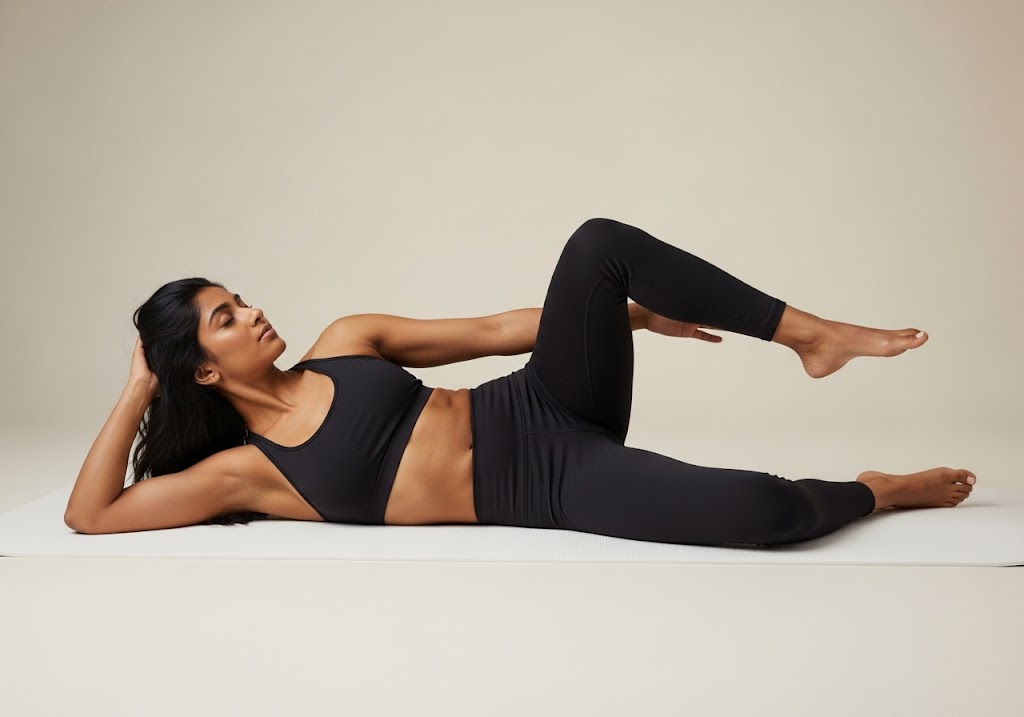
Recovery and Self-Care in Somatic Pilates
Recovery and self-care are integral parts of somatic Pilates practice, as the nervous system needs time to process and integrate new patterns. Understanding how to support this process enhances the benefits and prevents overwhelm.
- Rest and Integration periods allow your nervous system to consolidate the changes initiated during practice. This might involve simply lying quietly after practice or engaging in other gentle, nurturing activities.
- Hydration and Nutrition support the body’s healing processes and help flush toxins released during somatic work. Pay attention to your body’s needs and provide appropriate nourishment.
- Sleep Quality often improves with regular somatic practice, but you can support this by creating good sleep hygiene and using gentle somatic techniques before bed.
- Professional Support may be beneficial, especially when dealing with chronic pain or trauma. Somatic practitioners, massage therapists, and other bodyworkers can complement your self-practice.
For additional recovery techniques, understanding what is foam rolling provides complementary methods for muscle care and tension release.
Conclusion
Somatic Pilates offers a gentle yet powerful path to improved health, reduced pain, and enhanced body awareness through nervous system re-education. This practice teaches you to work with your body’s natural wisdom rather than against it, creating lasting changes that extend far beyond the exercise session. Whether you’re seeking relief from chronic pain, stress management tools, or simply a deeper connection with your body, somatic Pilates provides accessible and effective techniques that can transform your relationship with movement and support overall well-being throughout your daily life.
Want to master the calisthenics handstand and take your skills to the next level? Whether you’re a beginner or pushing advanced skills, ISC – Indian School of Calisthenics offers expert guidance to help you master bodyweight training. Visit us at SRPF Ground, NH8, Goregaon (E), Mumbai – 400065. For class schedules, personalized coaching, or more details, call +91 77159 53218. Train smart, move better, and unlock your back strength with ISC.
Somatic Pilates – FAQs
What is somatic Pilates?
Somatic Pilates combines traditional Pilates with somatic awareness techniques, emphasizing slow, mindful movements that retrain the nervous system and release chronic muscle tension.
What is somatic Pilates vs wall pilates?
Somatic Pilates focuses on nervous system re-education through gentle awareness, while wall Pilates uses wall support for traditional Pilates exercises and alignment.
Can you lose weight with somatic Pilates?
Somatic Pilates can support weight management through stress reduction and improved body awareness, but significant weight loss requires additional cardio and dietary changes.
What are somatic exercises for belly fat?
Gentle breathing exercises, pelvic tilts, and spinal waves can reduce stress-related belly fat by lowering cortisol levels and improving core awareness.
What is somatic Pilates vs yoga?
Somatic Pilates emphasizes nervous system education through micro-movements, while yoga combines poses, breathing, and philosophy for spiritual and physical development.
Is somatic exercise like yoga?
Somatic exercise shares yoga’s mindful approach but focuses specifically on nervous system re-education rather than traditional poses and spiritual practices.
What is meant by somatic exercise?
Somatic exercise involves slow, conscious movements that help you develop body awareness and release chronic tension through nervous system re-education.
What is the difference between yoga and Pilates?
Yoga emphasizes flexibility and spiritual connection through poses, while Pilates focuses on core strength and precise movement patterns for physical conditioning.
Do somatic Pilates really work?
Yes, research shows somatic Pilates effectively reduces chronic pain, improves movement quality, and enhances stress management through nervous system changes.
What style of yoga is somatic?
Somatic yoga emphasizes gentle, awareness-based movements similar to somatic exercise, focusing on internal sensation rather than achieving specific poses.
How do I start somatic exercise?
Begin with simple, slow movements like breathing awareness and gentle joint circles, focusing on internal sensations rather than external form.
What is the best exercise to flatten the stomach?
Core-strengthening exercises combined with cardiovascular activity and proper nutrition are most effective for reducing belly fat and flattening the stomach.
What is a somatic diet?
A somatic diet emphasizes mindful eating, anti-inflammatory foods, and paying attention to how different foods affect your body and energy levels.
Will Pilates slim your body?
Pilates can contribute to body slimming through improved muscle tone and posture, but significant weight loss requires cardiovascular exercise and caloric deficit.
What are the results of somatic Pilates?
Results include reduced chronic pain, improved body awareness, better movement quality, stress reduction, and enhanced overall well-being and life quality.
Do somatic exercises reduce cortisol?
Yes, the gentle, mindful nature of somatic exercises activates the relaxation response, which helps reduce cortisol levels and manage stress effectively.

